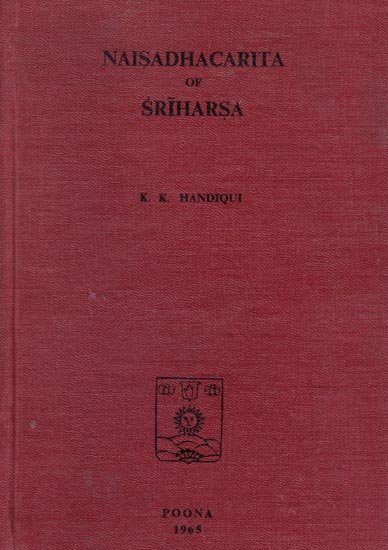Naishadha-charita of Shriharsha
by Krishna Kanta Handiqui | 1956 | 159,632 words
This page relates Introduction to Mallinatha’s commentary of the English translation of the Naishadha-charita of Shriharsha, dealing with the famous story of Nala (king of Nishadha) and Damayanti (daughter of Bhima, king of Vidarbha), which also occurs in the Mahabharata. The Naishadhacharita is considered as one of the five major epic poems (mahakavya) in Sanskrit literature.
Introduction to Mallinātha’s commentary
Mallinātha’s commentary on Naiṣadhacarita is known as Jīvātu, but the Palghat edition used by me goes as far as the eleventh Canto only. Mallinātha may be assigned to the fifteenth century or the latter portion of the fourteenth, as he wrote a commentary on Vidyādhara’s Ekāvalī composed in the first quarter of the fourteenth century.[1] His work has all the merits associated with his well-known commentaries on the other Kāvyas. Some of his readings are, however, very peculiar, and do not agree with those found in the other commentators.
The commentary of Mallinātha is particularly rich in lexicographical quotations. Apart from Amara and Viśvaprakāśa, the largest number of quotations is from Vaijayantī, which is also referred to as Yādava. I have examined some of these quotations, and find that they occur in Oppert’s edition. The same remark applies also to the citations from Halāyudha, the author of Abhidhānaratnamālā. Mallinātha quotes also Utpalamālā,[2] Śābdikamaṇḍana,[3] Śabdārṇava,[4] Amaraśeṣa,[5] the commentary of Kṣīrasvāmin,[6] and the lexicographers Śāśvata,[7] Keśava,[8] Dhanañjaya,[9] Ajayapāla or Ajapāla[10] and Bhojarāja.[11]
Among other authors he quotes the Bhāṣyakāra,[12] the Nyāsoddyotakāra,[13] Vāmana,[14] Kaiyaṭa,[15] Bhaṭṭamalla,[16] Varāhamihira,[20] Vāgbhaṭa,[18] and Pitāmaha.[19] The Bhūpāla quoted under 3.109 is Siṅgabhūpāla, the author of Rasārṇavasudhākara.[20] A definition of sugarcandy and varieties of sugar is cited from a Vaiśeṣikakāra in the gloss on 8.101.[21] A quotation from Mīmāṃsakas occurs in the gloss on 2.61.[22]
The foregoing statement of Mallinātha’s references is compiled from his commentary on the first eleven Cantos of Naiṣadha, but the importance of the lexicographical quotations will be seen even from the above list, as Malli quotes several lexicons which are no longer extant.[23] It may also be noted that Malli refers to his commentaries on Kirātārjunīya and Kumārasambhava in his gloss on Naiṣadha 5.71 and 8.99. On the other hand, he refers to Śrīharṣa’s poem in his commentaries on Raghuvaṃśa and Śiśupālavadha.[24]
Footnotes and references:
[1]:
See Trivedi’s Introduction to his edition of Ekāvalī (B. S. S.).
[2]:
Under 3.8; 5.66.
[3]:
Under 3.122; 11.38.
[4]:
Under 1.82; 3.21.
[6]:
Under 3.31.
[7]:
Under 3.36; 11.40.
[8]:
Under 11.15; 11.94.
[9]:
Under 12.49.
[10]:
Under 8.92; 9.29. The quotation under 8.92 is found in Nārāyaṇa also under the same verse. Under 7.66 Malli says “‘bhavenmāṇavako hārabhede bāle kupūruṣa’ ityabhidheyaḥ (?)”. The quotation occurs also in Nārāyaṇa and Viśveśvara under the same verse, but is attributed by them to Ajayapāla, and found in the Madras ed. of his Nānārthasaṃgraha.
[12]:
Under 3.80; 5, 71.
[13]:
3.52; 8.48.
[14]:
Under 11.3 etc.
[15]:
Under 11.47.
[16]:
Under 4.84; 7.90; 11.109.
[17]:
Under 11.81.
[18]:
See Notes 10.94.
[19]:
Under 7.23.
[20]:
Malli quotes the definition of “lāvaṇya” found in this work (1.181. Trivandrum S. S.).
[21]:
“atra dravye vaiśeṣikakāraḥ—matsyandikāḥ khaṇḍasitāḥ krameṇa guṇavattamāḥ |” etc. This line is quoted by Kṣīrasvāmin from Vāgbhaṭa while explaining Amara on “matsyaṇḍī”.
[22]:
See Appendix I. Section II (b).
[23]:
Of these, the Śabdāmava is frequently quoted by Sarvānanda who wrote his commentary on the Amarakoṣa in 1159 a.d. (See the Trivandrum edition). Sarvānanda quotes also the Utpalinī and Ajaya or Ajayakosa [Ajayakoṣa]. With regard to Bhoja, he is quoted by Kṣīrasvāmin (see Introduction to Oka’s edition).
